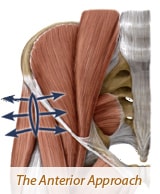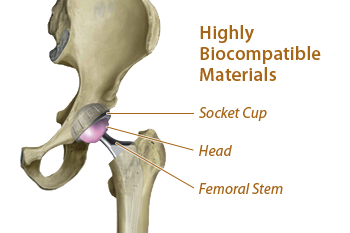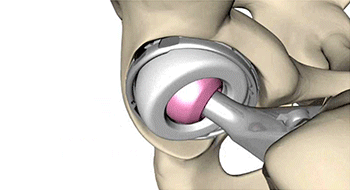Understanding Your Treatment
There are different ways to treat hip pain, and we can guide you to the best solution for your unique situation.
Non-operative Treatments
The first option we examine is non-operative treatments such as exercise and a healthy lifestyle. Leading a healthy lifestyle helps you reduce the pain caused by arthritis. This can include a modified diet for weight control, daily exercise, and physical therapy focused on strengthening your core and gluteal muscles. Upright bicycles and elliptical trainers are the best tolerated cardiac exercises.
Anti-Inflammatory medications (NSAIDs) and pain-relieving injections (corticosteroid) can also be helpful tools in a non-operative treatment course, although are not ideal for long term use.
Hip Replacement
Hip replacement, also known as hip arthroplasty, is a surgical procedure in which the hip joint is replaced by a prosthetic implant. The hip prosthesis is an artificial articulation with highly biocompatible materials that consists of a socket cup (acetabular shell and liner), head (sphere), and femoral stem.
Traditional Approach Versus the Minimally Invasive Anterior Approach
 In a total hip replacement, the surgeon can access the hip joint by different paths. A conventional (posterior) surgical approach requires the cutting of some muscles and tendons. Alternately, the anterior approach is a minimally invasive surgery, characterized by the preservation of muscles and tendons encountered during the surgery.
In a total hip replacement, the surgeon can access the hip joint by different paths. A conventional (posterior) surgical approach requires the cutting of some muscles and tendons. Alternately, the anterior approach is a minimally invasive surgery, characterized by the preservation of muscles and tendons encountered during the surgery.
The anterior minimally invasive surgery for total hip replacement is the only technique that allows a true muscle and nerve sparing surgery, which is fundamental for fast recovery.
- Anterior minimally invasive surgery can have many benefits:
- Decreased post-operative pain
- Shorter rehabilitation
- Shorter hospital stay
- Faster return to daily activities
- Reduced risk of dislocation (separation of the hip ball and socket)
- Reduced risk of limping
- No postoperative limitation of movements, usually prescribed with other techniques
Hip replacement has the potential to improve your quality of life by reducing hip pain and increasing range of motion. Contact us to learn if hip replacement might be right for you.





 Watch a video of the anterior minimally invasive surgery being performed.
Watch a video of the anterior minimally invasive surgery being performed.